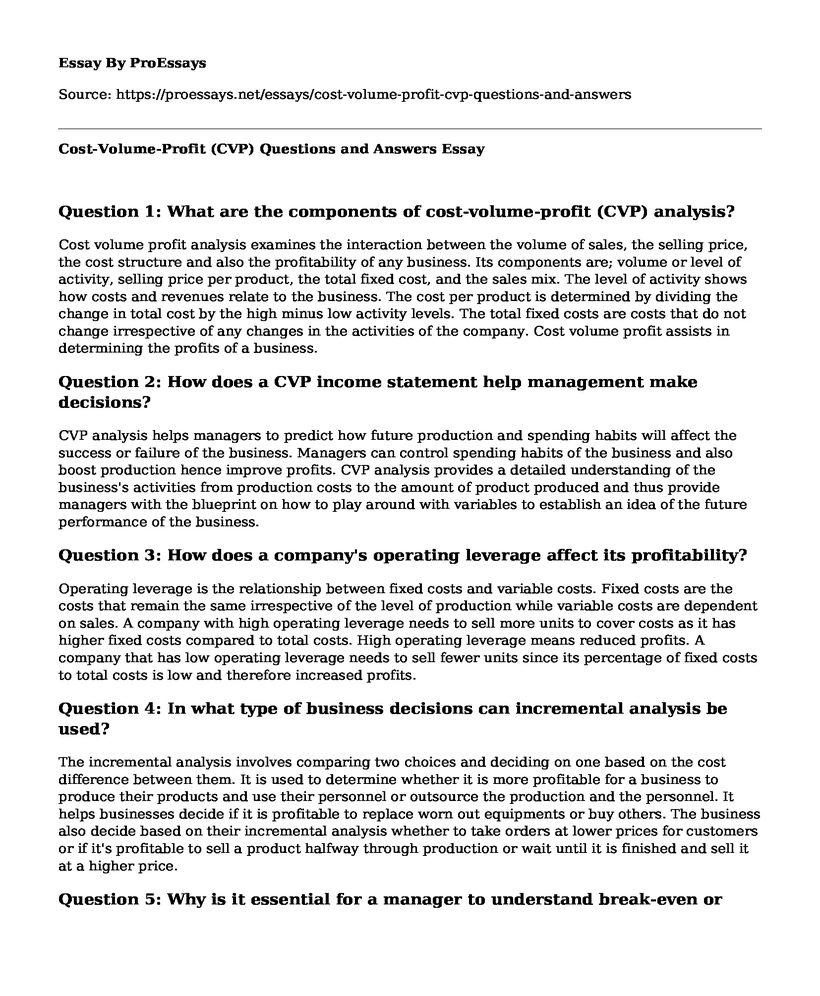Question 1: What are the components of cost-volume-profit (CVP) analysis?
Cost volume profit analysis examines the interaction between the volume of sales, the selling price, the cost structure and also the profitability of any business. Its components are; volume or level of activity, selling price per product, the total fixed cost, and the sales mix. The level of activity shows how costs and revenues relate to the business. The cost per product is determined by dividing the change in total cost by the high minus low activity levels. The total fixed costs are costs that do not change irrespective of any changes in the activities of the company. Cost volume profit assists in determining the profits of a business.
Question 2: How does a CVP income statement help management make decisions?
CVP analysis helps managers to predict how future production and spending habits will affect the success or failure of the business. Managers can control spending habits of the business and also boost production hence improve profits. CVP analysis provides a detailed understanding of the business's activities from production costs to the amount of product produced and thus provide managers with the blueprint on how to play around with variables to establish an idea of the future performance of the business.
Question 3: How does a company's operating leverage affect its profitability?
Operating leverage is the relationship between fixed costs and variable costs. Fixed costs are the costs that remain the same irrespective of the level of production while variable costs are dependent on sales. A company with high operating leverage needs to sell more units to cover costs as it has higher fixed costs compared to total costs. High operating leverage means reduced profits. A company that has low operating leverage needs to sell fewer units since its percentage of fixed costs to total costs is low and therefore increased profits.
Question 4: In what type of business decisions can incremental analysis be used?
The incremental analysis involves comparing two choices and deciding on one based on the cost difference between them. It is used to determine whether it is more profitable for a business to produce their products and use their personnel or outsource the production and the personnel. It helps businesses decide if it is profitable to replace worn out equipments or buy others. The business also decide based on their incremental analysis whether to take orders at lower prices for customers or if it's profitable to sell a product halfway through production or wait until it is finished and sell it at a higher price.
Question 5: Why is it essential for a manager to understand break-even or cost-volume-profit analysis?
Management uses breakeven analysis to understand how sales, cost, and volume of production relate to profits made. CVP analysis is used by managers to determine the level of sales whereby there will be neither losses nor profits made which is the breakeven point. CVP analysis is used in the calculation of the contribution margin that assists managers to know how much money is required to reach and surpass the breakeven point and make profits and also be able to know the company's profit.
Question 6: In what types of situations is incremental analysis most useful?
The incremental analysis is also known as marginal analysis helps businesses analyze incremental changes that might arise from all the alternative options available therefore inform their choice on the most favorable. In the scenario whereby a client requests the business to make a special order, the manager needs to decide whether that order will bring profits, what will the product be priced at to boost profits and if the company is capable of executing the order. Incremental analysis helps management to decide between repairing and purchasing new equipment when they get worn out.
Question 7: Please write a brief statement describing the article, why it relates to the course and what you found interesting about it.
The article analyzes incremental analysis and how it helps in decision making in business. He gives Delta airlines as an example and how they have used incremental analysis to make decisions that best suit them and their company concerning their aircraft, oil and also their staff. Kimmel's explanations and examples are helpful in emphasizing the importance of incremental analysis in businesses today. Jared Lewis (2018) in his article "Advantages and Disadvantages of Cost-Volume-Analysis," explains how CVP analysis assists management to make decisions that are profitable, and also how the relationship between fixed and variable costs or the operating leverage assists businesses to regulate their expenses to avoid losses and maximize profits.
Cite this page
Cost-Volume-Profit (CVP) Questions and Answers. (2022, May 17). Retrieved from https://proessays.net/essays/cost-volume-profit-cvp-questions-and-answers
If you are the original author of this essay and no longer wish to have it published on the ProEssays website, please click below to request its removal:
- Boeing Company Financial Analysis Essay
- Transformational-Leadership and Zero Based Budgeting Essay
- Rebuilt Title Car Isn't Bad Essay Example
- Essay Sample on Corporate Accounting Fraud: A Growing Problem
- Research Paper on The Banking Industry's Revolutionary History in the U.S.
- Essay Example on Company's Declining Revenue: Big Mart Bankruptcy & Fire Loss
- Tax Evasion: A Serious Crime With Serious Consequences - Essay Sample







